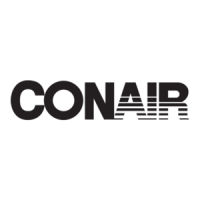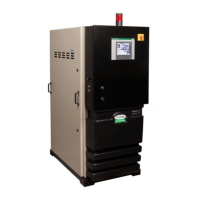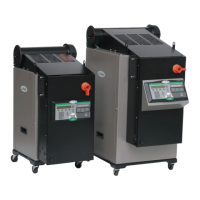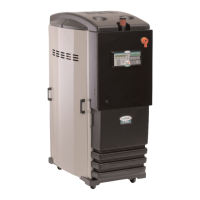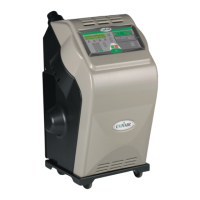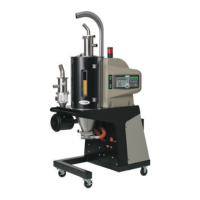
Do you have a question about the Conair MDCW Carousel Plus W15 and is the answer not in the manual?
| Type | Hair Dryer |
|---|---|
| Heat Settings | 3 |
| Speed Settings | 2 |
| Cool Shot Button | Yes |
| Ionic Conditioning | Yes |
| Concentrator Nozzle | Yes |
| Diffuser Nozzle | Yes |
| Power | 1875 W |
| Attachments | Concentrator, Diffuser |
Explains the purpose of the User Guide for installation, operation, and maintenance.
Details symbols used in the guide for highlighting important information.
Outlines user duties regarding safety, equipment, and manual adherence.
Lists critical safety warnings for installation, operation, and maintenance.
Provides step-by-step instructions for safely isolating equipment power.
Describes the self-contained, mobile unit for drying and conveying plastic resin.
Explains the self-loading option for conveying new material to the drying hopper.
Details where the MDCW Carousel Plus Dryer can be used successfully.
Explains the process, regeneration, and cooling cycles of the dryer.
Describes how dry air moves material from the drying hopper to the process machine.
Lists technical specifications such as air flow, temperature, dimensions, and power.
Details available options like volatile trap, precooler, and dryer communications.
Guides on how to safely remove and inspect dryer components from packaging.
Covers site requirements like power source, water source, and mounting bracket.
Provides steps for moving, mounting, and connecting the MDCW unit.
Details how to assemble vertical conveying tubes and flexible conveying hoses.
Explains how to plug the sensor cable into the MDCW frame connector.
Instructions for using flange and mounting clips for loaders on the hopper.
Guides on connecting tubes and sensor cables for the self-loading function.
Step-by-step instructions for safely connecting the main power supply.
Details connecting a compressed air source for the self-loading option.
Procedure to verify airflow direction before filling the hopper with material.
Instructions for connecting water supply and discharge lines to the aftercooler.
Steps to ensure all components are correctly installed and functioning.
Information on using optional Modbus, Ethernet, SPI, or DeviceNet communications.
Overview of the DC-2 control panel buttons, displays, and indicators.
Provides a summary of control functions and their corresponding screen numbers.
Explains how to use menu buttons and scroll keys to access settings.
Detailed descriptions of various screens and their functions on the control panel.
Step-by-step guide on how to initiate the drying process.
Instructions on how to properly stop the dryer and its cool-down procedure.
Guides on setting up and operating the optional self-loading feature.
Steps for connecting and operating the machine loader for conveying material.
Explains the procedure for entering the supervisor password to access settings.
Details on programming auto start and auto stop functions for the dryer.
How to protect the drying process by setting acceptable temperature limits.
Guides on using dewpoint monitor and control features for optimal drying.
Explains how the setback feature saves energy and prevents over-drying.
Provides recommended setpoint values for the setback feature.
Lists routine maintenance tasks and schedules for the dryer and receiver.
Procedures for monitoring dryer dewpoint performance with a portable meter.
Instructions for thoroughly cleaning the hopper, cone, and discharge assembly.
Steps to clean or replace the process filter to maintain dryer efficiency.
Procedure for accessing, cleaning, and replacing the regeneration filter.
How to clean the conveying filter to maintain airflow and blower performance.
Guides on cleaning the vacuum receiver and its mesh filter.
Instructions for cleaning the screen filter of the TLR loader.
Guidance on maintaining the moisture trap in the compressed air supply.
Steps to clean aftercooler coils for efficient operation.
Instructions for cleaning precooler coils if the optional unit is installed.
Checking hoses and gaskets for leaks and damage to prevent moisture ingress.
Initial steps to take before troubleshooting, including diagnosing from the control panel.
Important safety warnings regarding electrical hazards and hot surfaces.
Guides on interpreting alarm indicators and messages to diagnose issues.
Details shutdown alarm causes, solutions, and interpretation of the alarm LED.
Explains passive alarm causes, solutions, and LED indicator status.
Addresses issues related to the dryer not producing the desired dewpoint.
Helps identify causes for improper material drying, focusing on four key requirements.
Step-by-step instructions for safely replacing fuses in the dryer.
Procedure for testing and identifying faulty heater solid state relays.
How to check and replace RTD sensors used for temperature monitoring.
Detailed instructions for replacing the regeneration and process heater tubes.
Steps for replacing the desiccant wheel assembly to ensure performance.
Explains the Modbus protocol for accessing control boards and data.
Details the hardware required for Modbus communications and installation.
Guides on reading and writing data using the Modbus register list.
Explains the Modbus TCP/IP protocol applied to Ethernet for dryer communication.
Guides on changing the dryer's IP address for network integration.
Refers to Appendix A for available parameters for the Modbus TCP/IP interface.
Explains DeviceNet communication for PLC systems via a gateway device.
Details mounting and connecting the DeviceNet gateway hardware.
Configuration of DIP switches for gateway address, baud rate, and parameters.
Explains the meaning of LED indicators on the DeviceNet gateway.
Guides on installing EDS files and configuring parameters for DeviceNet.
Steps to add the gateway to the network scan list and configure I/O parameters.
How to write data to the gateway using DeviceNet Explicit messages.
Explains the SPI standard protocol for plastics equipment communication.
Details the hardware and connections for the SPI option.
Steps to set up and configure the SPI communication protocol.
Lists and describes the Select and Poll commands for SPI communication.
